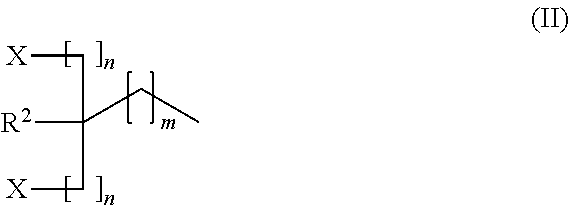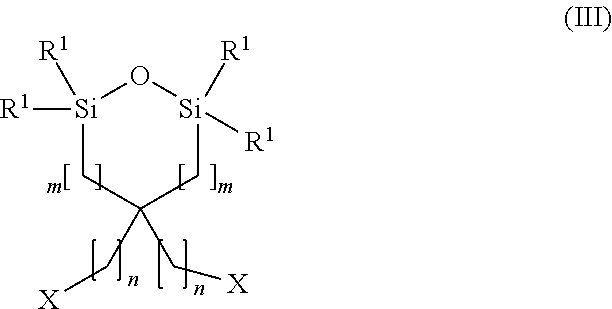Carbon dioxide absorbent and method of using the same
a technology of carbon dioxide and absorbent, which is applied in the direction of gaseous fuels, combustible gas purification/modification, separation processes, etc., can solve the problems of amine-based systems that are not designed for processing large volumes of flue gas, 83% increase in the overall cost of electricity from such a plant, and mea-based co/sub>2/sub>capture an undesirable choice for large-scale commercialization
- Summary
- Abstract
- Description
- Claims
- Application Information
AI Technical Summary
Benefits of technology
Problems solved by technology
Method used
Image
Examples
example 1
Preparation of Amino-Siloxane Composition (Ia)
[0043]
[0044]A solution of 1,3 -bis(2,2-dicyanobutyl)-1,1,3,3 -tetramethyldisiloxane (2.45 g, 7.1 mmol) in diethylether (25 mL) was added slowly over a period of 15 min to a mechanically stirred, pre-cooled slurry of lithium aluminum hydride (2.49 g, 65.7 mmol) in diethylether (275 mL) at a temperature of about 0° C. under N2, in order to maintain the temperature of the mixture below 5° C. The mixture was stirred for 6 hours, followed by addition of water (10 mL), 1 M NaOH (40 mL) and water (50 mL), in the given order, with vigorous stirring. This was followed by the addition of diethylether (100 mL). The reaction mixture was then extracted with additional portions of diethylether (4×100 mL). The diethylether layers were combined, dried with Na2SO4, filtered and concentrated to an oil. The aqueous layer was further extracted with CHCl3 (3×30 mL), and treated, following the method described above. The crude products were combined; dissolve...
example 2
Preparation of Amino-Siloxane Composition (Ib)
[0049]
[0050]To a solution of 2-ethylmalononitrile (2.0 g, 21.2 mmol) in tetrahydrofuran (THF, 10 mL) at 0° C. was added potassium t-butoxide (1.75 g, 15.6 mmol), to provide a clear brown solution. A solution of 1,3-bis(iodomethyl)1,1,3,3-tetramethyldisiloxane (2.93 g, 14.2 mmol) in THF (6 mL) was added drop-wise, using an addition funnel, when all the potassium t-butoxide had dissolved. On completion of the addition of the above solution, a fresh portion of THF (6 mL) was used to rinse the addition funnel. The reaction mixture was then allowed to warm to room temperature. As the reaction preceded, the solution lightened in color and solid-precipitated. At the end of three days, the reaction mixture was filtered, and the solids were washed with THF. The solution was concentrated on a rotary evaporator and the residue thus obtained was partitioned between chloroform and water. The organics combined and were washed with water, dilute sodium...
example 3
Preparation of Amino-Siloxane Composition (Ic)
[0056]
[0057]To a solution of malononitrile (8.42 g, 127 mmols) in THF (35 mL) at 0° C., was added potassium t-butoxide (5.15 g, 45.9 mmols). The resulting milky pink solution was stirred under nitrogen for 15 minutes, followed by dropwise addition of 1,3 -bis(3 -iodopropyl)-1,1,3,3 -tetramethyldisiloxane (10.0 g, 42.5 mmol) in THF (10 mL) over a period of 20 minutes, using an addition funnel. The addition funnel was rinsed using THF (5 mL). The reaction mixture was allowed to warm to room temperature and allowed to stay overnight. At the end of the stipulated time, the THF was removed using a rotary evaporator, and the residue was partitioned between chloroform and 10% HCl. The organics were then washed twice with deionized water and once each with dilute NaHSO3, water, and saturated sodium chloride. Following the washing step, the organics were dried over anhydrous sodium sulfate, and the solvent was removed on a rotary evaporator to yi...
PUM
| Property | Measurement | Unit |
|---|---|---|
| temperatures | aaaaa | aaaaa |
| weight | aaaaa | aaaaa |
| temperature | aaaaa | aaaaa |
Abstract
Description
Claims
Application Information
 Login to View More
Login to View More - R&D
- Intellectual Property
- Life Sciences
- Materials
- Tech Scout
- Unparalleled Data Quality
- Higher Quality Content
- 60% Fewer Hallucinations
Browse by: Latest US Patents, China's latest patents, Technical Efficacy Thesaurus, Application Domain, Technology Topic, Popular Technical Reports.
© 2025 PatSnap. All rights reserved.Legal|Privacy policy|Modern Slavery Act Transparency Statement|Sitemap|About US| Contact US: help@patsnap.com



